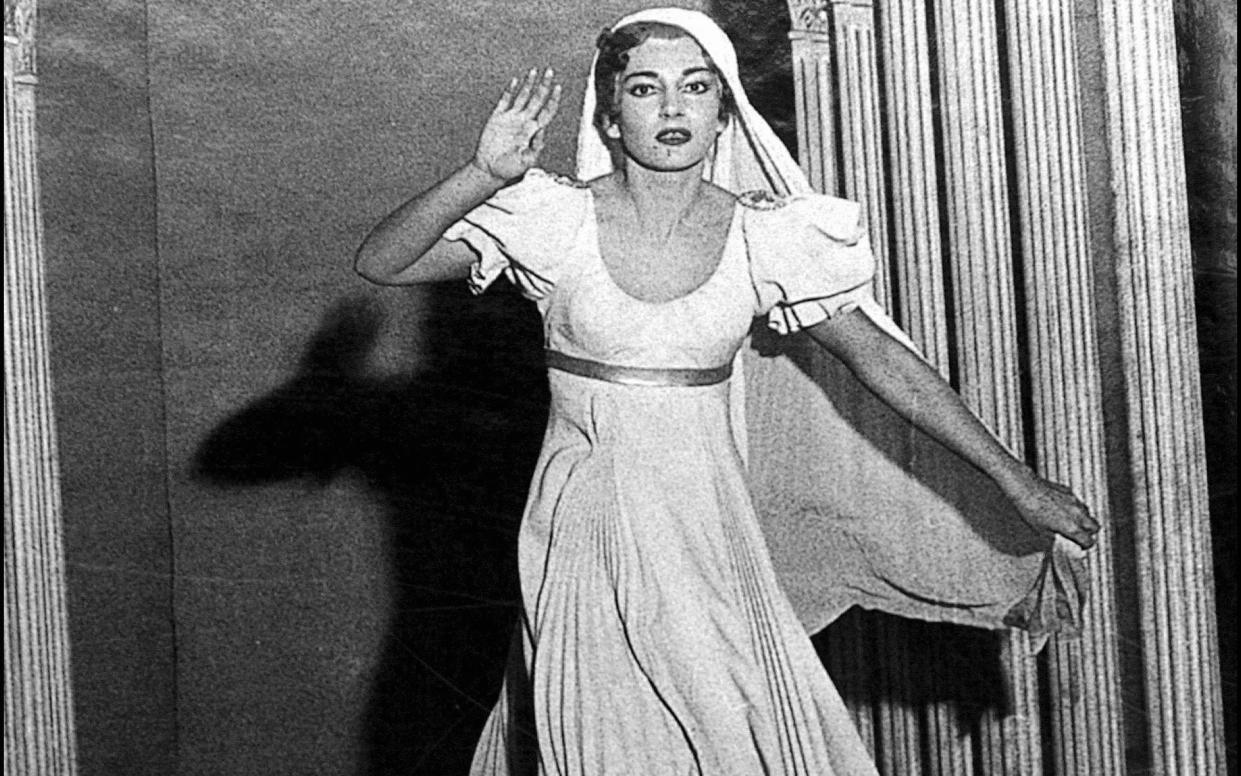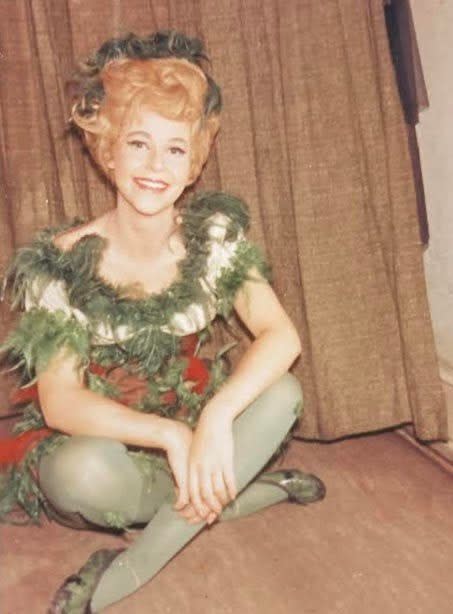Why Maria Callas is my ultimate operatic heroine

- Oops!Something went wrong.Please try again later.
- Oops!Something went wrong.Please try again later.
I first saw this wonderful picture (above) of Maria Callas more than 30 years ago, when I was 18 and working as an au pair in Milan. It was being used for a poster for an exhibition commemorating her at La Scala, the scene of some of her most fêted triumphs, and was plastered all over the place.
So often did I come across it that I felt like it haunted me, this image of a woman caught so immersed in a role that the flash of the photograph has traversed time to show us a startled Roman priestess – not a 20th-century opera singer at all. Callas, 30 at the time, in 1954, was playing the heroine of the now little-known 1807 opera La vestale by the Italian composer Gaspare Spontini in a production notable for being the first opera directed by celebrated filmmaker Luchino Visconti. Perhaps it was he who came up with that stunning colonnade.
I bought a copy of the poster and carefully carried it across Europe in a cardboard tube as I went Interrailing. I then left it on the train at Ostend, my last stop before the ferry home, a loss that, with no exaggeration, upsets me to this day. It was startling and moving to see it again last week, when a simple Google search retrieved it for me.
In a way, Callas, born in New York to Greek parents 100 years ago this weekend, has haunted me all my life. Although I was only three when Callas died a recluse in Paris in 1977, my mother was such a devoted fan that I was brought up with the sound of her voice in the house, played on fuzzy and clattery but powerfully atmospheric live recordings on increasingly battered vinyl. Oft repeated to me was the tragic trajectory of her personal life – that her jilting by Aristotle Onassis for the even more glamorous Jaqueline Kennedy would ruin her, body and soul.
My mother had become an opera singer because she heard Callas singing La Traviata on the radio in 1958 – when she was 16 and the star was in her greatest decade. My mother would go on to train at the Royal College of Music and perform professionally as a light soprano at Vienna State Opera and Stadttheater Bern before motherhood intervened. But Callas remained her idol.

She had a big Thames & Hudson hardback book of pictures of her in her greatest roles that I would leaf through on my knees in the dining room. We still have it, Callas: The Art and the Life – The Great Years, and it comes with essays by critics John Ardoin and Gerald Fitzgerald (though I never read the words – this was just a picture book to me). Taking it off the shelf last week, I found it had been given by my father to my mother – they first bonded through their shared love of opera – on the occasion of my christening.
The pictures in it fascinated me because I could see, as is the case with the photograph from La vestale, an actress consumed by the parts she played – roles that so often required her to be tormented, betrayed or otherwise stricken. No performer could inhabit these states, so my mother taught me, the way Callas could.
There was Callas out of her mind as Lucia di Lammermoor, driven to murder by betrayal; Callas as Elisabetta di Valois, imperious as she endures marriage to a man she does not love for the sake of peace in Europe; Callas eyes ablaze with hate as Floria Tosca.
Divorced from the sound of her voice, these images still communicate powerfully the drama she brought to these roles. Her beauty – and Callas was very beautiful – at the service of the characters is often twisted quite out of shape, just like she was famously willing to twist her voice out of shape for the sake of the anguished moment.
My mother would explain that it was a single particular scene, a particular moment really, in the radio broadcast of Callas’s La traviata in 1958 that had stopped her in her tracks. This was when Violetta, Verdi’s heroine and a former courtesan, has decided she will give up the love of her life, Alfredo, on the beseeching of his father so as not to besmirch the family name by their association.
To stop her lover preventing her from leaving him, she cannot tell him what she’s about to do. So she pretends she is just going out for the day. As she tears herself away from him she sings: “Amami, Alfredo...” – Love me Alfredo – as the strings start pulling at your nerves and the drum roll builds, “...quant’io ti adoro” – as I adore you. She rushes off with a parting “Addio”.

It’s one of the emotional peaks in the most famous opera in the world, and the most fabulous voices of the 21st century these days drown us in a sort of gorgeous sorrow at this point – look up Anna Netrebko singing it – but Callas does something quite different. Feverish, wild, preceded by coughing sobs, everything has become more extreme. Indeed the original lyrics have “Quant’io t’amo” – love me as I love you – but Callas has ramped “love you” up to “adore you”. The “Amami” sounds so desperate it appears to be summoning the gods themselves, not just Alfredo, to witness, while the “Addio” is absolutely frantic. It’s as if Callas embodies the very concept of despair – she takes it to its abstract state.
Having been taught to love opera as a child, I’ve seen a great deal of it now, as an adult. But, come to think of it, my whole understanding of it is coloured by how Callas did opera. I believe opera is the greatest art form because it investigates the peaks of emotion with such relentless force and attention. It distills love and grief to their abstract and thus their purest and most sublime forms. Callas offered herself up as a vessel for doing this.
Among the essays about Callas in the Thames & Hudson book, now sadly out of print although you can buy it on eBay, Italian director Sandro Sequi is quoted, and explains far better than I can what I have come to understand Callas uniquely did: “To sing opera requires a tremendous amount of energy, and it might seem twice the drain on the physique of a singer to coordinate the body with the voice. But the opposite is true, as Callas proved. Both things can go together, indeed must go together. That is why Callas is remembered as no other singer, however beautifully others may have sung. For me she was extremely stylised and classic, yet at the same time human – but humanity on a higher plane of existence… Realism was foreign to her, and that is why she was the greatest of opera singers.”
My mother is not very well these days, but just this week she texted to tell me of an archive interview with Callas on the BBC that I “must watch”. Part of the Soprano Sundays series, it is indeed fascinating. In it, Callas talks of how she understood herself as “an instrument of the orchestra”, that “prima donna” should be understood literally as first woman of the orchestra, like a first violin. It is, as my mother said, “a detailed masterclass”.
The legend of Callas now in the popular consciousness is in danger of being reduced to that of a demanding diva with personal problems. There are few people left who can remember seeing her live in her prime. But many recordings were made of those performances, and you can buy or download the recording of that very night my mother heard on the radio – made on June 20 1958 – from Amazon, and I urge you to do so. It has something of the supernatural about it.
The Callas Conversations (Parts One and Two) are on BBC iPlayer

